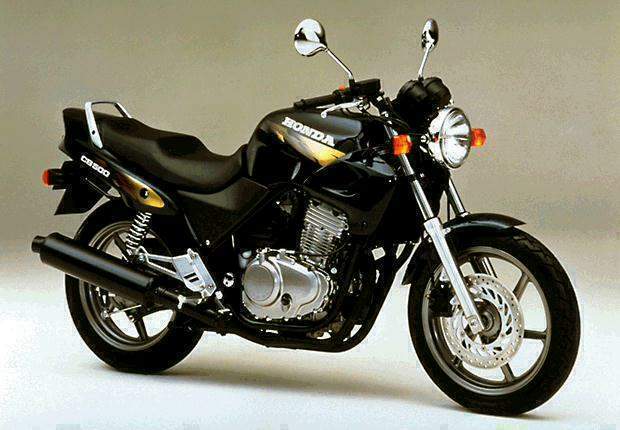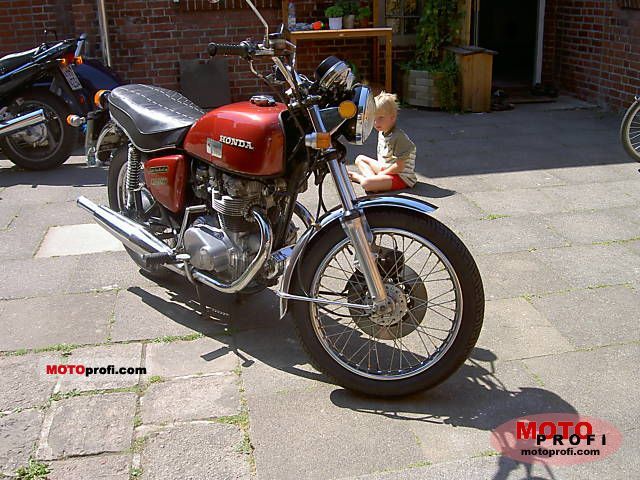Honda CB500 twin
Cooling: liquid cooling Fuel system: Keihin CV carburetors Ø 34 mm Starting system: electric start Ignition system: Contactless digital transistorised
Translations: Pinion / sprocket: 15/ 40 teeth Primary: 1,947 Secondary: 2,666 1st gear: 3.461 2nd gear: 2,235 3rd gear: 1,750 4th gear: 1.478 5th gear: 1,280 6th gear: 1,130
Rear: drum brake Ø 160 mm ( PC26 PC32 (1996)), Single disc Ø 240 mm ( PC32, from model year 1997)
The Honda CB 500 is a naked bike with two-cylinder engine of the Japanese manufacturer Honda and was built from 1993 to 2002. 2003 Sales of the last machine took place.
Due to its robustness, the good-natured chassis and low cost, it is an attractive motorcycle for novice drivers, she was also in driving schools popular as a training machine. This rise in the meantime, however, often around to the new model Honda CBF 500 or other models with ABS.
- 4.1 57/58 hp
- 4.2 50 hp
- 4.3 34 hp
- 4.4 Leistungsteigerungskit
General
The two-cylinder CB500 should not be confused with the CB500 Four, the popular four-cylinder 1971, or even the rare Honda CB 500 T, a two-cylinder 1970 based on the legendary CB450 K.
Competitors the Honda CB500 for example, were the Suzuki GS 500E or the Kawasaki ER -5
History
The CB500 was developed by Honda as a convenient class motorcycle. Unlike other 500s of the 1990s, the CB500 was an engine that was completely redesigned. In this class, Honda offered last to the model Honda CB 450 S whose engine design still based ( air-cooled OHC twin cylinder with three valves ) on the 1977 featured CB400 Twin.
After setting the Honda CB450 S 1990 a gaping gap in the Honda program. Interested in this class chose to competing models like the Kawasaki GPZ 500 S, Suzuki GS 500E or the Yamaha XV535 Virago. Therefore, the water-cooled CB500 was developed, not least under pressure from the German importer.
When launched in 1993 it cost 9260 DM Meanwhile, the price was raised to 9,660 DM. In the spring of 1996, the price has been reduced by 700 to 8,960 DM with relocation to Italy. The last list price at the end of production was 5,090 euros. In addition, Honda offered since 1998, a sister model called CB500S with half cowling on, who owned other instruments and mirrors, but otherwise was identical in design to the CB500.
Model development / Year Codes
The bike has a double cradle frame made of steel tube ( steering head angle 27 °, caster 113 mm). Front telescopic fork provides a ( Ø 37 mm, 130 mm travel ) and rear swing arm with a two struts (spring travel 117 mm ) together with the weight of 193 kg ( ready to drive) for safe driving.
The PC26 motor of the CB500 ( Bore: 73.0 mm Stroke: 59.6 mm Compression ratio: 10.5:1 ) was unchanged in the successor model Honda CBF 500-2008 use, but there exhaust cleaned after Euro 2 by an unregulated catalyst and a secondary air system. The CB500 uses about 5 l/100 km regular gasoline, the tank has a volume of 18 l, 2.5 l reserve.
The Year codes are internal names of Honda and not to be confused with the type name. Similarly, the imprint " PC26 ", which refers to the engine covers all CB500 - 500 is the successor models and Honda CBF, independent of the model code.
CB500 -R (Model Code PC26 ) 1993-1995
- Front Disc Brake by Nissin
- Rear drum brake
- Silver Hand brake and clutch levers
- Fork lowers with drain plugs, preload bushing 20 cm and fork spring length 308.3 mm
- Headlight unit of Stanley, metal housing
- Indicators of Stanley
- Available in the colors red, green, blue and black
- Production in Japan
CB500 -T ( Model Code PC32 ) in 1996
- Special case because technically almost identical with PC26
- Front Disc Brake by Nissin
- Rear drum brake
- Fork lowers with drain plugs, fork spring length 509.9 mm
- Headlight unit of Stanley, metal housing
- Indicators of Stanley
- Available in the colors red, green, blue and black
- Production in Italy
CB500 - V (Model Code PC32 ) from November 1996
- Front disc brakes from Brembo
- Also rear disc brakes from Brembo
- Black Hand brake and clutch levers
- Fork lowers without drain plugs, preload bushing 10 cm and fork spring length 409.1 mm
- Headlight unit of Hella, plastic housing
- Indicators of CEV
- Production in Italy
CB500 - W & CB500S -W from 1998
- Available in the colors red, yellow, silver and black (from August 1999, in Orange )
- S version: Sport version with half cowling, angular headlights and modified instruments
CB500 -X & CB500S -X from December 1998
- No changes
CB500 - Y & CB500S -Y 2000-2002
- Shortening of the rear fender (elimination of screwed splash guard )
- Matt Gray Hand brake and clutch levers
- 2000 and 2001: Golden Silver instead of cast aluminum rims
- Available colors Red, Metallic Blue and Black
Model code PC33
Parallel to the PC32 series was built by a special version of the Honda CB500 for the Austrian market. This model carries the code PC33 and differs from the products sold in Germany PC32 only by a secondary air system that was needed to meet the law.
Power levels
57/58 hp
- Type PC26 G/PC32 G
- VIN ... PC26 -2 ... or ... PC32A ...
- Motorcycle without power constraint
- Top speed 193 km / h
- Power: 43 kW at 9500 min-1
- Stationary noise at 4750 min -1: 86 dB ( A)
- Drive-by: 78 dB ( A)
- Open Manifold
- 122er main jets
- Carburetor slide springs 16050MY5660
- Acceleration / with pillion (0-100 km / h): 5.2 / 6.9 s
- After changing the standard from 1998: 42 kW (57 hp)
50 PS
- Type PC26-2G/PC32 2G
- VIN ... PC26 -3 ... or ... PC32B ...
- Motorcycle with power constraint
- Top speed 183 km / h
- Power: 37 kW at 9500 min-1
- Stationary noise at 4750 min -1: 86 dB ( A)
- Drive-by: 78 dB ( A)
- Changed intake ( Marking: 37 kW)
- 122er main jets
- Carburetor slide springs 16050MY5660
34 hp
- Type PC26 3G/PC32 3G
- VIN ... PC26 -4 ... or ... PC32C ...
- Motorcycle with power constraint
- Top speed 158 km / h
- Power: 25 kW at 8500 min-1
- Stationary noise at 4750 min -1: 85 dB ( A)
- Drive-by: 76 dB (A)
- Changed intake ( Marking: 25 kW)
- 125 main jet
- Carburetor slide springs 16050MY5710
Leistungsteigerungskit
In the aftermarket chip tuning is - Kit available for the CB500, with which the motor can be brought to an output of 60 hp. This accessory is curious, however, interesting only for driving schools since the unrestricted A driving test and training are required on a machine with at least 60 hp. In everyday traffic, an increase of 2 HP is not perceptible only by the maximum design power scattering.
Costs
The motor vehicle tax annual cost of 36 euros because of the small engine displacement. Depending on the damage bonus and Regional class about 30 to 150 euros are due annually on insurance premium. Collision insurance is also relatively inexpensive for the CB500. The longevity of the drive was 04/ 1996 on 50,000 km highlighted in long-distance test of the magazine MOTORCYCLE; the determined cost per kilometer of converted 9 cents and 14 cents with no losses in value were among the best ever determined values . The French magazine MOTO REVUE drove to 2001 150.000 km at the 1993 CB500 ( PC26 ). Despite winter, racing and even off-road operation came to an apparently caused by crash bar frame breakage while no defects. Also from private collections are known well over 100,000 km mileages. Used cars are today, depending on the condition and mileage, usually traded between 1000 and 2000 Euros, particularly well-preserved two-wheelers accessories achieve also awards over 2000 euros.










